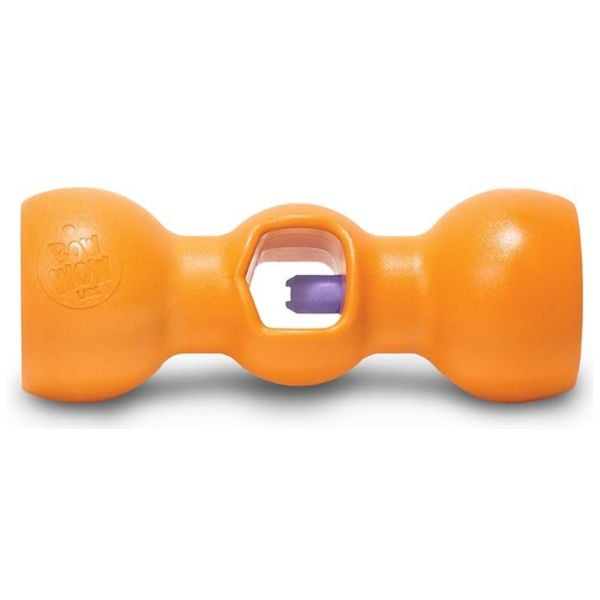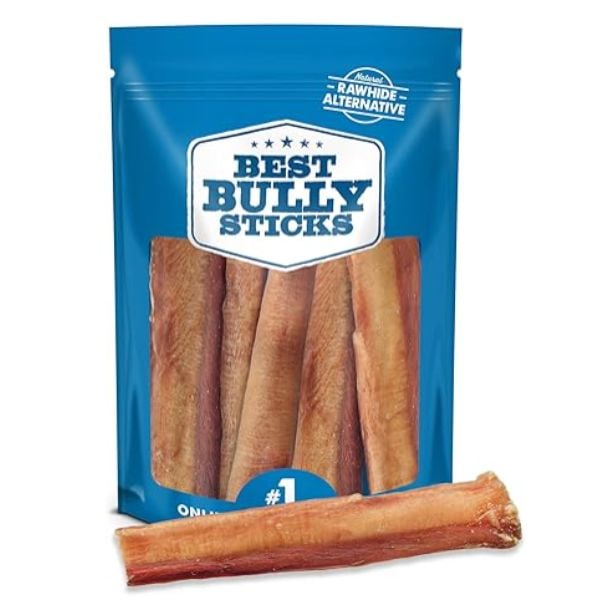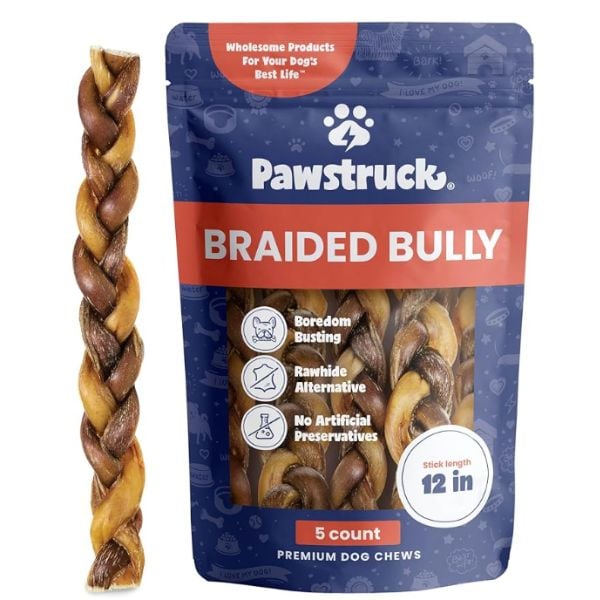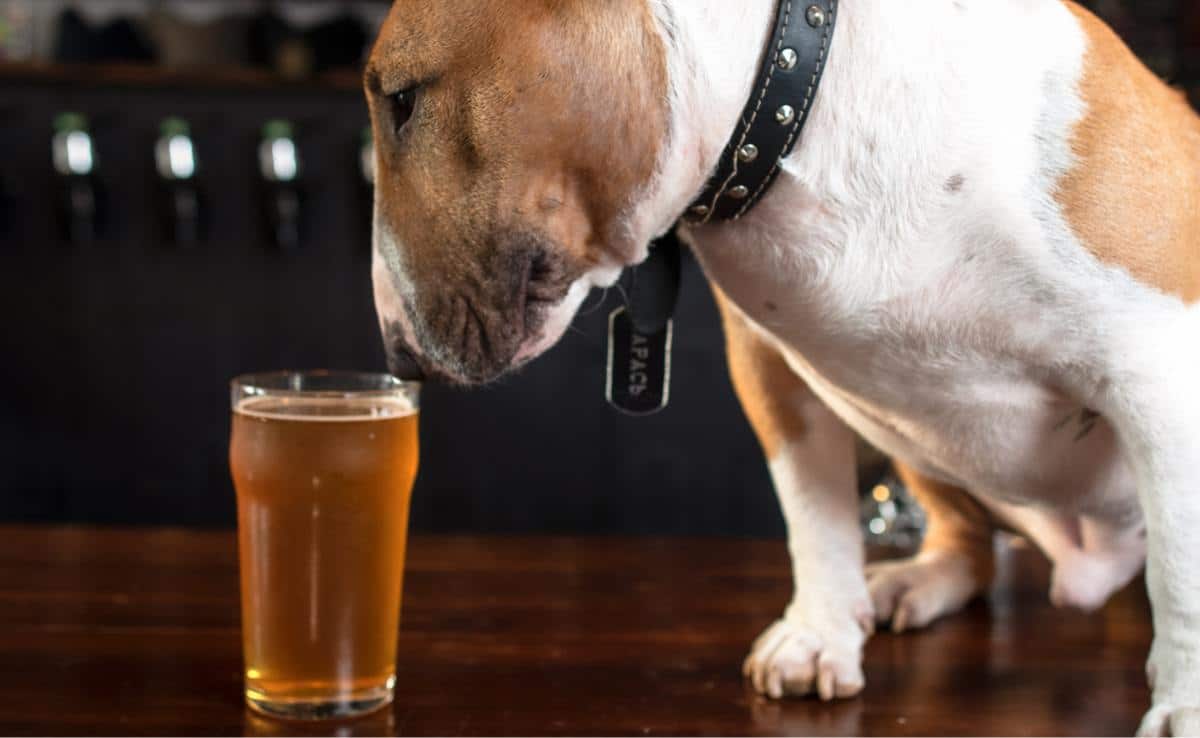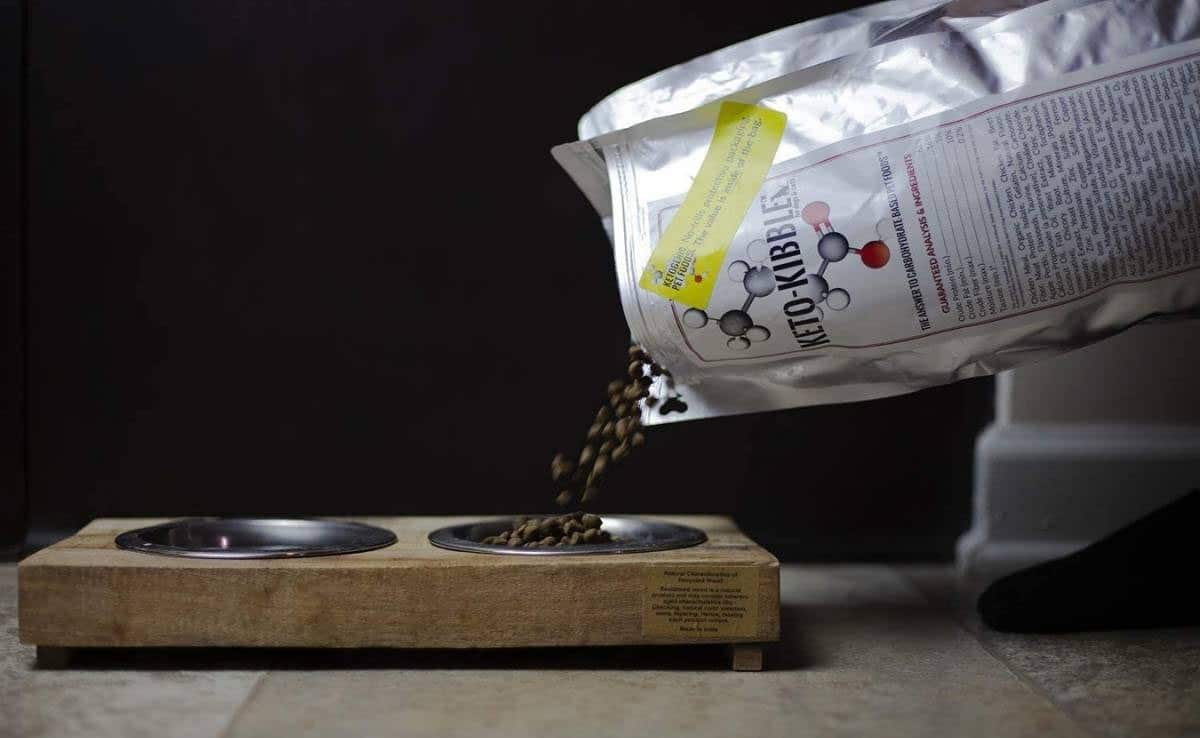Are Bully Sticks Good For Dogs? The Gross Truth You Need To Know
When you purchase through links on our site, we may earn a commission. Here’s how it works.
You gave your dog a chew stick… and then Googled it in horror. Yep, bully sticks are exactly what you think they are (and somehow, worse).
Table of Contents
But are they actually good for dogs, or just a bacteria-loaded, calorie-packed vet bill waiting to happen? Let’s break down the gross truth, the real risks, and why some vets still say “yes” anyway.
What Are Bully Sticks Made Of?
Let’s not sugarcoat it: bully sticks are made from 100% bull penis. The official ingredient? Beef pizzle. The unofficial reaction? “Wait… I gave my dog WHAT?”

They’re cleaned, stretched, and slow-dried (or baked) into the chewy brown sticks dogs go wild for. Some are twisted, braided, or even puffed, but they’re all the same body part.
Quick Takeaway:
- Ingredient: 100% bull penis (aka pizzle, an old-fashioned word for penis)
- Often labeled as “steer sticks” to sound less gross
- Some are bleached or chemically treated to reduce odor
- Origin matters – U.S.-sourced = safer, stricter handling rules
They are also called beef pizzles, bully bones, bully chews, pizzle sticks, or steer sticks.
Why So Gross… Yet So Popular?
Despite the ick factor, bully sticks are considered “natural” chews because they’re:
- Single-ingredient
- Free from artificial additives
- Fully digestible for most dogs
Pizzles are 100% beef tendon; they are tasty, all-natural, and high in protein and other nutrients. Good quality bully sticks should be chemical-free.
The manufacturers drain and air-dry the pizzles before marketing them for your dog’s enjoyment. Some manufacturers also bake them, and others flavor them.
Many of these animal-derived treats also last significantly longer than similar products on the market, such as rawhide or bones. Beef pizzles should be kept in an air-tight container to maintain freshness.
But “natural” doesn’t always mean “safe”, especially when some brands don’t disclose where the meat comes from or how it’s processed.
Learn more about whether dogs can eat bones and the safest types to eat.
Are Bully Sticks Safe For Dogs?
So now you know what they are. The question is: should your dog actually eat one? The short answer? Yes, but only if you use them smartly.
Here’s the full breakdown:
The Good: Why Some Vets Still Recommend Them
There’s conflicting information about the safety of bully sticks for dogs, and many people wonder if beef pizzle is safe for dogs. Most of the buzz on the web from veterinarians and all-natural dog-product websites says these chews are safe and are:
- High in protein (often 80–90%)
- Fully digestible – unlike rawhide, they break down in the gut
- Great for dental health – chewing helps reduce plaque and tartar
- Single ingredient – no dyes, chemicals, or hidden fillers
- Long-lasting – can keep power chewers busy for 15–45 minutes
- Good source of Taurine – an amino acid that contributes to your dog’s heart, muscle, and eyesight health.
Although they are great for dental health, make sure that the bully stick isn’t too hard for your dog’s teeth. Otherwise, it could cause a tooth injury. A good rule of thumb is that it’s not too hard if you can indent the chew with a fingernail.
Some vets even prefer bully sticks over rawhide or nylon bones, especially for dogs with sensitive stomachs.
Still unsure about whether bully sticks are good for dogs? Here’s what the American Kennel Club (AKC) has to say about them:
Bully sticks offer a variety of potential health benefits for your pet. They are digestible, unlike some other chews or treats. The beef hide in rawhide, for example, can be difficult to digest for some dogs. Bully sticks, on the other hand, are highly digestible, which means that they break down easily in your dog’s stomach.
Since bully sticks don’t splinter, you don’t have to worry about broken pieces causing any internal injuries. Bully sticks are a tasty, single-ingredient treat, made from high-protein beef muscle. Beef muscle is a complete source of amino acids, which support your dog’s muscles, brain, skin, and coat.
– American Kennel Club
The Not-So-Good: 5 Risks You Need to Know
They’re marketed as natural. Vets use them. Dogs love them. So… are bully sticks actually safe for your pup? The Truth: They’re safe-ish, but not risk-free.
Here’s what you need to watch out for:
1. Bacteria Exposure
Studies (like the one from Tufts University) have found Salmonella, Clostridium difficile, and E. coli on store-bought bully sticks. Even if your dog is fine, you (or your toddler) might not be.
2. High in Calories
Unfortunately, some online sources say they are low-fat, but this isn’t true. Treats should make up no more than 10% of their diet, but what does this mean for bully sticks?
A single 6-inch bully stick can contain a significant chunk of a small dog’s daily calorie needs. Too many can lead to weight gain and digestive upset.

A study found that a six-inch bully stick contained approximately 90 calories. For a 50-pound dog, this accounts for 9% of their daily calorie requirements. If you were to give the same six-inch pizzle stick to a 10-pound dog, this would equate to 30% of their daily calorie intake.
Considering the “10% treat rule,” this means the right size bully stick is the only treat they are allowed that day. If you offer them a larger stick, they exceed their daily calories and risk becoming overweight very quickly. This is why many nutritionists recommend pizzle sticks should be a bi-weekly indulgence.
Check out our informative guide on how heavy your dog should be, complete with dog weight charts.
3. Choking and Blockage Hazards
Dogs that chew aggressively can bite off a big chunk and swallow it whole. If it’s not fully digested, it can cause an intestinal blockage, especially in smaller dogs.
That last 1–2 inches is the most common culprit. Many dogs try to swallow it whole, which can block the esophagus or cause choking.
If your dog recently ate a bully stick and shows any of these symptoms or signs of a potential blockage, call your vet:
- Vomiting or dry heaving
- Bloated or hard stomach
- Lack of appetite
- Straining to poop or no bowel movements
- Weakness or whining
These could indicate a partial or full intestinal blockage, which may require emergency care.
4. Digestive Upset
Some dogs simply don’t tolerate rich chews like bully sticks, especially if they’re new to them. Diarrhea and vomiting are common signs. Dogs with sensitive stomachs or a history of pancreatitis may struggle to digest high-fat chews, such as bully sticks, even small ones.
Giving bully sticks too frequently (especially to small dogs) can overwhelm their system and increase the risk of vomiting, diarrhea, or poor digestion.
5. Unclear Sourcing
Not all bully sticks are created equal. Some come from grass-fed U.S. cattle, processed in USDA-regulated facilities. Others? Not so much.
If it’s not U.S.-sourced or labeled clearly, there’s no telling how the product was cleaned, processed, or stored. Here’s the sourcing breakdown:
| Source | Pros | Cons |
|---|---|---|
| USA | Safer handling, USDA oversight, and often odor-controlled | Slightly more expensive |
| Brazil | Common import source, sometimes grass-fed | Less oversight, inconsistent labeling |
| Unlabeled origin | Often cheaper | High risk of poor processing, chemical treatment, or contamination |
Always check the label. If it doesn’t say “sourced and processed in the USA,” assume it’s not.
Here’s How To Make Them Safer
- Use bully stick holders to prevent swallowing
- Always supervise
- Throw away the small end pieces
- Limit to 1–2 sticks per week (based on your dog’s size)
- Buy U.S.-sourced, low-odor versions for better safety control
I recommend using the Bow Wow Bully Stick Holder, a durable chew holder made in the USA, specifically designed to prevent dogs from choking on the last bit of bully sticks or other long-lasting chews.
It uses a “Twist Screw” mechanism with three pressure points to grip bully sticks (and even split antlers and collagen sticks), ensuring they stay securely in place during aggressive chewing.
The product is available in five size options, it’s third-party tested, veterinarian-recommended (vets use it to reduce choking incidents), and backed by a 100% satisfaction guarantee.
Don’t Forget Human Hygiene
Many pet parents overlook this: bully sticks can carry harmful bacteria, including Salmonella and E. coli. Remember, Tufts Veterinary School tested several and found contamination on retail samples.
To protect yourself and your family:
- Wash your hands thoroughly after handling
- Don’t let kids touch or feed bully sticks
- Use a clean surface (not your carpet or dog bed)
- Refrigerate half-chewed sticks in a sealed container
Dr. Gaylord, a board-certified veterinary nutritionist and diplomate of the American College of Veterinary Internal Medicine, states that proper handling is particularly important for households with immunocompromised family members.
Quick Takeaway: Bully sticks can be a healthy and satisfying treat if you choose them carefully and supervise their use. For aggressive chewers and anxious dogs, they’re often worth it. But for small puppies or unmonitored snackers? Think twice.
Can Puppies Have Bully Sticks?
Puppies chew everything, from shoes to table legs to your expensive earbuds. So giving them a bully stick seems like a win… but not so fast.
While bully sticks can be safe for puppies, they’re not for every pup, and they’re definitely not a free-for-all.

When Are Bully Sticks Safe for Puppies?
- Over 6 months old: Puppies under 6 months often don’t have the jaw strength or digestive readiness for dense chews
- Supervised at all times: No solo chewing; bully sticks can splinter or get swallowed in chunks
- Only in short sessions: Limit to 10–15 minutes to prevent overexertion or tummy trouble
- Proper size and shape: Use thin or mini sticks made for puppies, not the braided logs made for adult power chewers
- No other chews that day: Too many treats or rich snacks can upset their sensitive gut
Why Bully Sticks Can Be Risky for Puppies
- Choking hazard: Smaller mouths = higher risk of swallowing large pieces
- Hard to digest: Young puppies may not break it down well, leading to vomiting or diarrhea
- Calorie overload: Puppies have tiny daily calorie budgets, and even a small stick can push them over
- Still-developing teeth: Tough chews can damage fragile baby teeth or misalign jaw growth
Safer Puppy Chew Alternatives
Most puppies lose their baby teeth by six months of age. Learn more about puppy teeth and teething and ways to soothe their discomfort.
Here are some bully stick alternatives for puppies:
- Freeze a wet washcloth for sore gums
- Try soft puppy dental chews (made for teething)
- Offer carrots or ice cubes as soothing, natural options
- Use rubber or silicone chew toys, which are easier on developing jaws
Bottom line: Bully sticks can be safe for puppies, but only if they’re older than 6 months, chewing under supervision, and eating size-appropriate sticks. For teething pups, start with gentler options.
Best Bully Sticks
Ready to try a bully stick, but don’t want to risk the cheap, stinky, or sketchy stuff? Here are two recommended brands that pass the safety, smell, and sourcing test.
Best Bully Sticks Review
View on Amazon | View on Chewy
I recommend Best Bully Sticks as our editor’s number-one choice if you plan to try this product for your dog. These bully sticks are baked and lab-tested in the U.S., sourced from bulls that are free-range and grass-fed.
They are all-natural, chemical-free treats that are odorless, which is great if you can’t stomach the typical dog-treat smell. Plus, they come in a range of sizes catering to different breeds.
This brand also offers treats in other shapes to keep your pup interested, including pretzels, spirals, braids, bows, and more. Take a look at this short video on why bully sticks are good for dogs.
Price
Pawstruck Natural Braided Bully Sticks Review
View on Amazon | View on Chewy
Pawstruck’s Braided Bully Sticks are a step above your standard chew thanks to their braided design, which weaves three bully sticks together into a thicker, longer-lasting treat. This makes them especially ideal for power chewers who tear through single sticks in minutes.
Made from 100% natural beef pizzle sourced from the USA, these chews are free from additives, chemicals, or artificial preservatives, keeping things simple, digestible, and safe for most dogs.
While they’re not completely odor-free (because, well, they’re still beef parts), they’re baked to reduce smell without harsh bleaching agents.
Price
Compare these products with our other highly rated options in our best bully stick guide.
Which Bully Sticks Last The Longest?
Some sticks are gone in minutes. Others keep power chewers busy for nearly an hour. Here’s how they compare:
| Type | Chew Time | Best For |
|---|---|---|
| Braided bully sticks | Longest | Heavy chewers |
| Standard 6″ stick | 10–30 minutes | Medium chewers |
| Thin/mini sticks | Under 10 minutes | Small dogs, seniors |
| Odor-free versions | Same as regular | Indoor use, humans with noses |
Reminder: Bully stick lifespan depends on your dog. A 15-lb dachshund = slow. A 70-lb lab = instant obliteration.
Bully Sticks vs Rawhide: What’s Safer?
If you’ve ever stood in the pet aisle holding a rawhide in one hand and a bully stick in the other, you’re not alone.
There are many horror stories about rawhide, and most vets recommend choosing bully sticks over rawhide. Bully sticks are made from a bull’s pizzle, which is muscle tissue that is easy on their stomachs and high in protein.
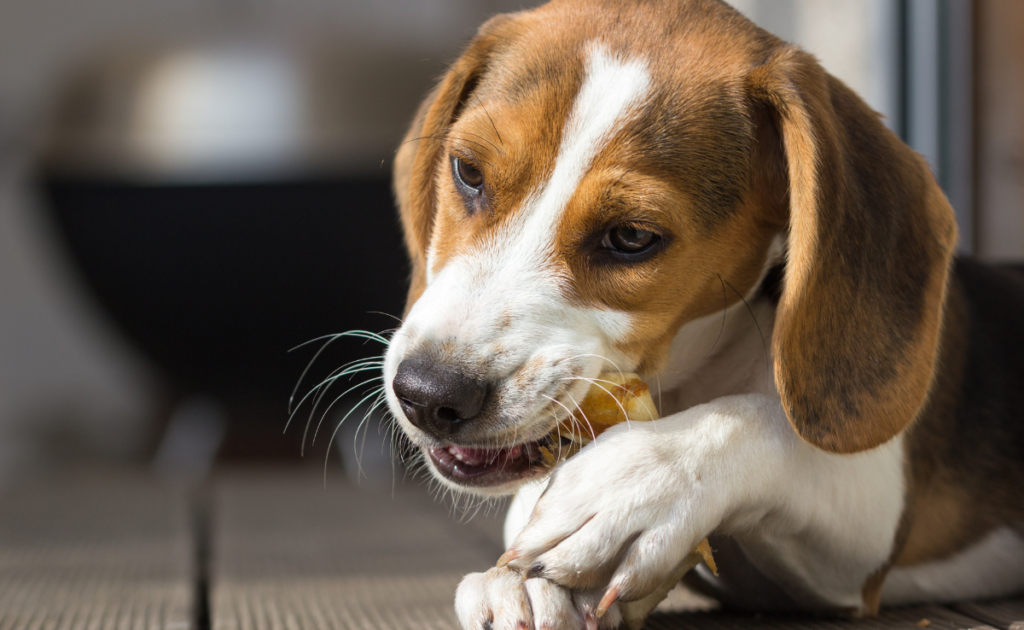
While rawhide is any animal’s inner soft hide or skin, it is more difficult to digest and poses a choking risk. However, rawhide is popular because it is much cheaper.
Unfortunately, many rawhide products are treated with chemicals, making them potentially unsafe depending on the product you purchase.
Let’s break down how they really compare, from digestibility to dental health to risk level:
| Feature | Bully Stick | Rawhide |
|---|---|---|
| Main Ingredient | 100% beef pizzle (muscle) | Processed cow hide (leather by-product) |
| Digestibility | Fully digestible | Not digestible (swells in the gut) |
| Choking/Blockage Risk | Low to moderate (if supervised) | High (can cause severe obstructions) |
| Additives | Typically none | May contain bleach, glue, or preservatives |
| Smell Factor | Low to strong, varies by brand | Usually odorless |
| Cost | Moderate to high | Low |
Learn more about rawhide bones, their dangers, and how to pick the safest options. We also have a guide on the best rawhide alternatives to consider.
Are Bully Sticks Safe For Dogs: FAQs Answered
We know that some of our readers have questions about bully sticks and whether they are safe for dogs to eat. If you don’t see your question below, please ask us in the comments, and we’ll find the answer for you.
Do Vets Recommend Bully Sticks?
Yes, many vets recommend bully sticks as a treat for dogs. Not only are they rich in protein and other nutrients, but these all-natural options are much safer than cheaper alternatives such as rawhide. Plus, they are great for their teeth and gums and for removing plaque.
You must choose all-natural bully sticks that contain no chemical additives or preservatives. These can have dangerous side effects and cause allergic reactions in some dogs.
Are Bully Sticks Bad For Dogs?
No, bully sticks are not bad for dogs if you choose an all-natural option made by a reputable brand, like my recommendations above.
You must also select the right size for your pup to ensure they don’t become a choking hazard. They are also calorific, which means they are not the best option, at least not regularly, for overweight dogs.
Can Bully Sticks Cause A Blockage?
Like with any chew, bully sticks can cause a blockage. As your dog chews the stick down, it can become small enough that your dog tries to swallow it whole. But it can become lodged in your dog’s throat, or if it passes through, it can also cause a blockage in their stomach or intestines.
It’s essential to monitor your dog when they are chewing a bully stick and to remove it once it becomes small enough that they might swallow it. This is more of a concern for puppies and small dogs, but it is a risk for all dogs.
Are Bully Sticks Safe For Puppies?
Puppies over 6 months old can safely enjoy bully sticks in moderation. Younger pups may risk choking, stomach upset, or tooth damage. From 6 months, use only puppy-sized sticks and always supervise.
Do Bully Sticks Smell Bad?
Some do. The strongest-smelling bully sticks are usually untreated or imported. “Odor-free” versions are baked to reduce odors without the use of bleach. U.S.-sourced, low-odor sticks are your best bet for indoor use.
How Long Should a Dog Chew a Bully Stick?
Most dogs should chew for 10–20 minutes per session, but some larger breeds can chew up to 45 minutes with a tough, braided bully stick. For small breeds, any duration longer than 20 minutes increases the risk of overconsumption or sore gums. Remove the stick once it has softened or become short.
Can Bully Sticks Go Bad?
Yes. Like any natural treat, they can spoil, especially if left half-chewed and unsealed. Store in an air-tight container or fridge, and toss if they smell off or feel slimy.
Are Bully Sticks Safe For Humans To Handle?
Some pet parents question whether bully sticks are safe for humans to handle. It’s essential to wash your hands after handling pizzle sticks, just like you would after handling raw meat. Humans are much more prone to Salmonella than dogs, so you must be careful when handling them.
How Can Pet Insurance Help?
Our furry friends are susceptible to so many accidents and illnesses throughout their lives. Treatment and surgery for everything from a bully stick intestinal obstruction to a cancer diagnosis can result in thousands of dollars in vet bills. However, a reasonable monthly premium for pet insurance can cover a significant portion of your vet expenses for emergencies, accidents, and unforeseen illnesses.
You never want to face the decision of sacrificing your dog’s health and well-being because you can’t afford treatment. Check out our best pet insurance guide to see if it’s a worthy investment for your family.
Other Dog Toys & Ways To Entertain Fido
Pet parents rave about bully sticks as a long-lasting, healthy chew alternative for your dog. Sure, not all are safe, but we trust Best Bully Sticks and Pawstruck.
If you’re looking for other chew alternatives and toys for your dog, check out our guide on the best dog toys. Alternatively, you can make your own organic dog treats or freeze-dried treats to satisfy your dog’s need to chew.
If you have a smart canine, be sure to head over to our review of the best interactive dog toys to stimulate Fido. And be sure to check out our guide on how to create an agility course in your backyard.
Got a Bully Stick Story? Did your dog love their first bully stick… or launch it across the room in disgust? Ever catch them trying to bury one in your couch cushions? We want to hear it. So, drop your funniest, grossest, or most “omg” bully stick moments in the comments below.
